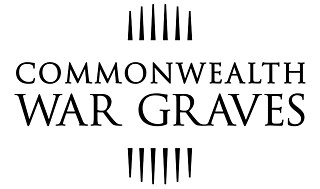
The Commonwealth War Graves Commission (CWGC) is an intergovernmental organisation of six independent member states whose principal function is to mark, record and maintain the graves and places of commemoration of Commonwealth of Nations military service members who died in the two World Wars. The commission is also responsible for commemorating Commonwealth civilians who died as a result of enemy action during the Second World War. The commission was founded by Sir Fabian Ware and constituted through Royal Charter in 1917 as the Imperial War Graves Commission. The change to the present name took place in 1960.

The Tower Hill Memorial is a pair of Commonwealth War Graves Commission memorials in Trinity Square Gardens, on Tower Hill in London, England. The memorials, one for the First World War and one for the Second, commemorate civilian, merchant seafarers and fishermen who were killed as a result of enemy action and have no known grave. The first, the Mercantile Marine War Memorial, was designed by Sir Edwin Lutyens and unveiled in 1928; the second, the Merchant Seamen's Memorial, was designed by Sir Edward Maufe and unveiled in 1955. A third memorial, commemorating merchant seamen who were killed in the 1982 Falklands War, was added to the site in 2005.
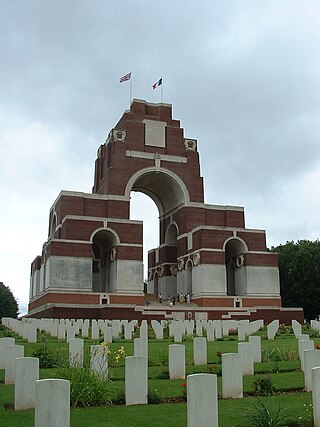
The Thiepval Memorial to the Missing of the Somme is a war memorial to 72,337 missing British and South African servicemen who died in the Battles of the Somme of the First World War between 1915 and 1918, with no known grave. It is near the village of Thiepval, Picardy in France. A visitors' centre opened in 2004. Designed by Sir Edwin Lutyens, Thiepval has been described as "the greatest executed British work of monumental architecture of the twentieth century".

Francis Walter Stafford McLaren was a British Member of Parliament killed in the First World War in a flying accident.
Vizeflugmeister Hans Goerth was a World War I German flying ace credited with seven confirmed aerial victories. He was the top ace of Marine Feld Jasta III of the German Naval Air Service, and was one of the few aces allowed to fly the Fokker E.V monoplane. Goerth received the Iron Cross First Class and other awards for his service. After the war, in 1919, the pilot participated in Kampfgeschwader Sachsenberg, commanded by fellow World War I ace Gotthard Sachsenberg.
Awdry Morris Vaucour, was a First World War flying ace credited with seven aerial victories. For part of his career he flew with observer/gunner Alan Bott, who would go on to become an ace in his own right. Vaucour was killed in Italy in a "friendly fire" incident, when he was shot down by an Italian Hanriot pilot.
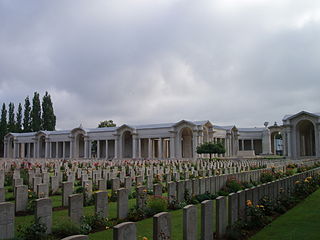
The Arras Memorial is a World War I memorial in France, located in the Faubourg d'Amiens British Cemetery, in the western part of the town of Arras. The memorial commemorates 35,942 soldiers of the forces of the United Kingdom, South Africa and New Zealand, with no known grave, who died in the Arras sector between the spring of 1916 and 7 August 1918.
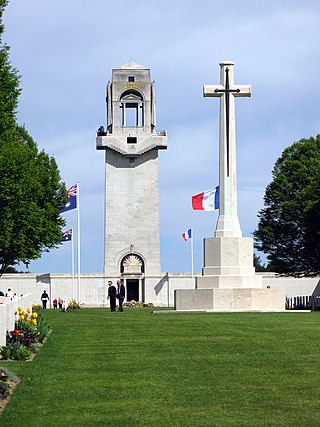
The Australian National Memorial, Villers-Bretonneux is the main memorial to Australian military personnel killed on the Western Front during World War I. It is located on the Route Villiers-Bretonneux (D 23), between the towns of Fouilloy and Villers-Bretonneux, in the Somme département, France. The memorial lists 10,773 names of soldiers of the Australian Imperial Force with no known grave who were killed between 1916, when Australian forces arrived in France and Belgium, and the end of the war. The location was chosen to commemorate the role played by Australian soldiers in the Second Battle of Villers-Bretonneux.
Captain Walter Alexander Tyrrell was a British First World War flying ace credited with seventeen aerial victories.

Hubert Dunsterville Harvey-Kelly, was a British Army officer and military aviator. During the First World War, he was credited with being the first Royal Flying Corps (RFC) pilot to land in France, and of being the first RFC pilot to down an enemy aircraft. He was eventually shot down during Bloody April and died of head wounds in a German hospital.

Founded in 1917, the Ramscappelle Road Military Cemetery is located two kilometers east of the city of Nieuwpoort in the province of West Flanders (West-Vlaanderen), Belgium. It is on the N367, the road which leads from Nieuwpoort to the village of Sint-Joris, near the intersection with Ramscappelle Road (Ramskapellestraat).
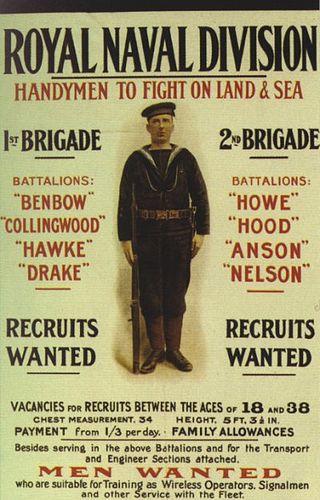
Serjeant Mechanic Edwin Edward Hunnisett was a World War I British aviator who was shot down by German flying ace Hans Goerth.
Lieutenant Valentine St. Barbe Collins was a World War I British flying ace credited with ten aerial victories who served with the Royal Flying Corps and the Royal Air Force.

Lieutenant Pruett Mullens Dennett was a World War I British flying ace. He was credited with ten aerial victories, the last occurring on the day he was killed in combat.
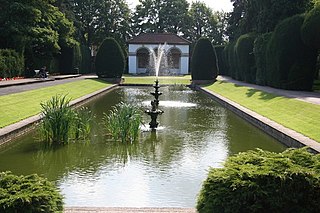
Spalding War Memorial is a First World War memorial in the gardens of Ayscoughfee Hall in Spalding, Lincolnshire, in eastern England. It was designed by the architect Sir Edwin Lutyens. The proposal for a memorial to Spalding's war dead originated in January 1918 with Barbara McLaren, whose husband and the town's Member of Parliament, Francis McLaren, was killed in a flying accident during the war. She engaged Lutyens via a family connection and the architect produced a plan for a grand memorial cloister surrounding a circular pond, in the middle of which would be a cross. The memorial was to be built in the formal gardens of Ayscoughfee Hall, which was owned by the local district council. When McLaren approached the council with her proposal, it generated considerable debate within the community and several alternative schemes were suggested. After a public meeting and a vote in 1919, a reduced-scale version of McLaren's proposal emerged as the preferred option, in conjunction with a clock on the town's corn exchange building.

Northampton War Memorial, officially the Town and County War Memorial, is a First World War memorial on Wood Hill in the centre of Northampton, the county town of Northamptonshire, in central England. Designed by architect Sir Edwin Lutyens, it is a Stone of Remembrance flanked by twin obelisks draped with painted stone flags standing in a small garden in what was once part of the churchyard of All Saints' Church.

The Leeds Rifles War Memorial is a First World War memorial outside Leeds Minster on Kirkgate in Leeds, West Yorkshire in northern England. The memorial was designed by Sir Edwin Lutyens, one of 15 instances of his War Cross and the only one commissioned by a regiment. The memorial, dedicated to members of the Leeds Rifles who fell in the First World War, was unveiled on Remembrance Sunday, 13 November 1921, and is today a grade II listed building.

A statue of Captain Albert Ball stands in Nottingham Castle Gardens, in Nottingham, England. It comprises a bronze sculpture by Henry Poole which depicts the British fighter pilot Captain Albert Ball VC DSO & Two Bars, MC accompanied by an allegorical female figure, standing on a stone pedestal by the architect Edwin Alfred Rickards. The memorial was unveiled in 1921, was listed at Grade II in 1972, upgraded to Grade I in 2017.
















